
Email; one of the main means of communication today. Almost everyone uses email. Many devices (PCs, laptops, phones, tablets, game consoles, etc.) facilitate email exchange. Email is important in the business world. Email is important in the personal world. Email is important. Not surprisingly, cybercriminals use it as a weapon in their famous conquests. And this weapon was very effective.
What is Email Spoofing?
The word spoof means deception. Email is terminated when the sender intentionally changes parts of the email to appear that the message was made by someone else.
Usually, the sender's name, email address, and message body are displayed from the official source. Sometimes a spoofer gives the impression that the email is from a private person. A fake message may appear to be from a family member, coworker, bank, or any other number of sources that are trusted. A good spoof is just like any other email you get.
This has been done with spam for some time now. Their previous strategy was to collect contact lists from malware-infected computers and send large emails to your contacts. Current thieves include fishers, criminals who steal personal information or credentials from financial accounts and paid malware liability.
Today's attacks are often complex and polished. Surprisingly, the necessary email click tools are readily available. Data theft is probably the most disturbing bullying problem you can face because you can't stop it. Identity theft is like writing a lot of letters and signing someone else's name. You can imagine how difficult it can be to find them.
Why do people create fake emails?
Often, an email generated is part of an attack on identity theft. In some cases, someone uses fraudulent email to misrepresent an online service or sell a faulty product. The purpose of sending a fraudulent email and defective product is to trick the recipient into making a negative statement or disclosing sensitive information, such as passwords. If you receive bounce emails for messages you have never sent, it could be a case of impersonation.
Modern email-based attacks have fake email titles and are often spiced up with social engineering tools that make the malicious pill more attractive. Bad people know that people have lost hope (for the most part) in many previous emails and messages, even if the sender maybe someone who knows the victim. The headlines are less likely to claim to have won this or that. In the business sector, fraudulent emails may refer to products or services used by your company, or, in highly targeted cases, emails may contain the names of family, friends, and others closest to you. A sense of urgency often accompanies these emails. Anglers often use it to scare their victims. A tired and anxious victim may follow instructions in an email and fall into the trap of a robber.
So, what can be done to protect yourself?
● Email Measures for Technical Fraud
Believe it or not, one of the most important reasons for email fraud is user awareness.
All in all, with the current technology full of landmines, a healthy measure of skepticism can go a long way. Think before you act! Do not simply click through the eyes to see if a link or attachment is coming to you. Doubt is good these days. If something does not sound right, stop, take a break, and examine again. Contact your IT team or managed security provider for assistance if you conclude that you need help with email or at least a second eye. Do not attempt to resolve this issue if you are uncomfortable or are aware of email-based antics. Let the technical experts take care of it.
Strive to combat email Spoofing. Keep yourself and your partner informed of the types of incoming threats and keep up with the changing strategies and trends.
● Fight Identity Theft
User training is the first way to protect yourself from these types of attacks. If you receive a fake message, do the following activities:
- Block any email or IP list you have decided may be fraudulent.
- Change your email account password as soon as you or your users have provided such information at any time.
The biggest changes you can make as an administrator are to distribute SPF (Sender Policy Framework), DKIM (DomainKeys Identified Mail), and DMARC (Domain Message Authentication Reporting and Compliance) records accordingly. These draft records include additional layers of protection to prevent malicious emails from being sent using your legal domain name.
Ultimately, we users are the ones who need to be careful enough to spot such scams in today's world and not rely on legitimate emails, even if only from Google. You will face a difficult time performing criminal activities to steal sensitive information in the future. To secure your digital identity and your online surfing experience, visit IP Router Login. They have simple yet detailed guides, tutorials and access guides to configure your router and your home networking devices for the best possible online experience.












0 Comments